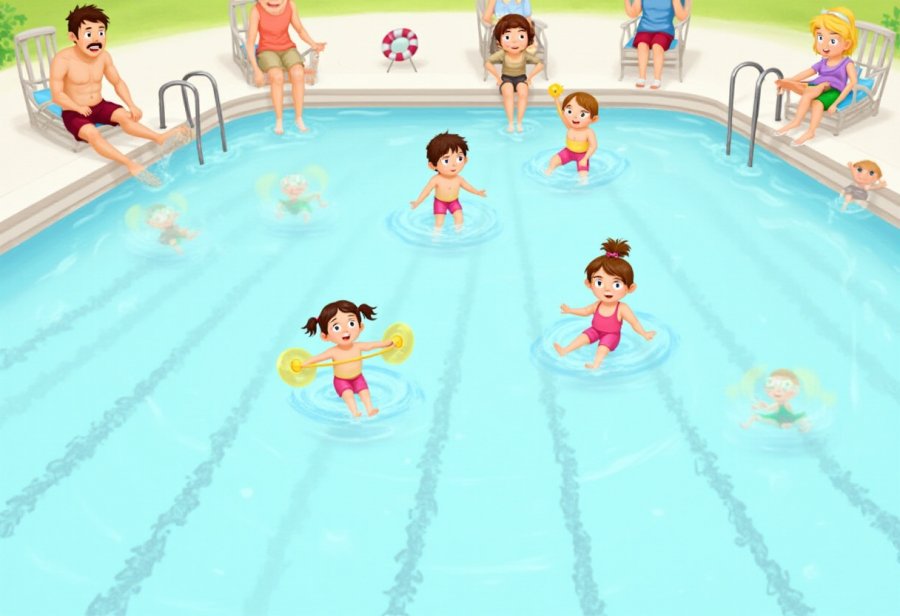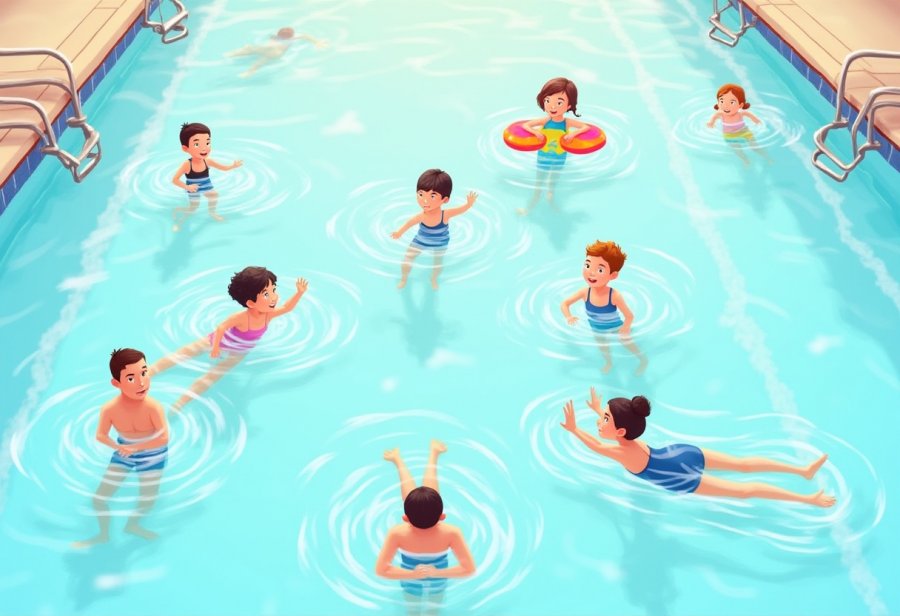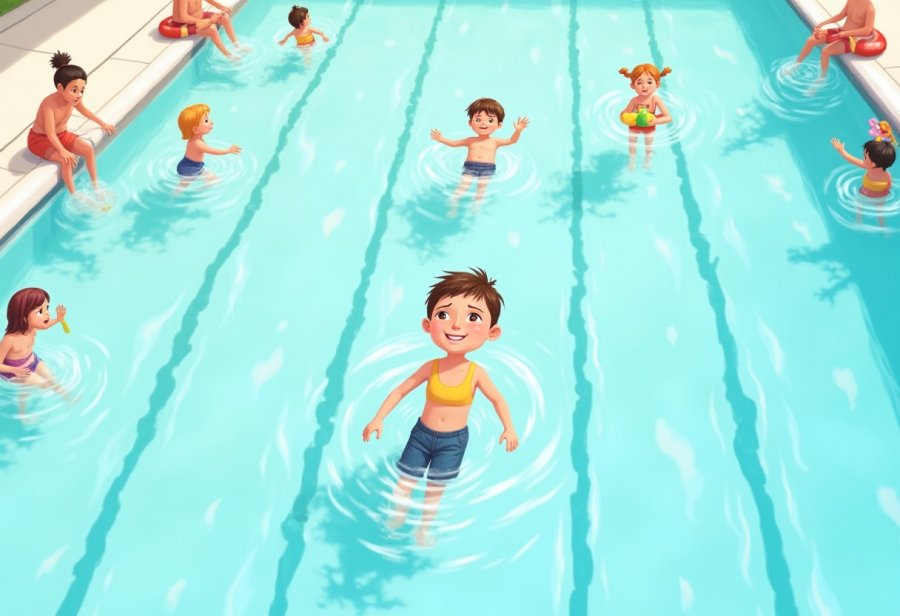
What if the greatest obstacle to learning to swim is simply taking that first courageous step? This inspiring guide reveals how water confidence can transform fears into freedom at any age, emphasizing that progress, not perfection, is the key. From nervous beginners dipping toes in to adults overcoming lifelong anxieties, each small victory builds safety, joy, and independence. The journey begins with foundational activities—floating, breathing, and gentle wading—that demystify water and foster trust. Proven strategies, tailored to all ages, focus on patience, relaxation, and gradual mastery, transforming water from a source of anxiety into a space of empowerment. Beyond safety, learning to swim offers profound health benefits and personal resilience, opening the door to richer social and recreational experiences. Are you ready to turn water from an intimidating challenge into a lifelong source of confidence, adventure, and joy? The journey starts with that first brave splash.

Transform Water Anxiety into Confidence: The Power of Learning to Swim
Learning to swim isn’t just about mastering strokes or techniques; it’s a skill that can truly change how you see and interact with water. For many, the idea of stepping into a pool or ocean can bring feelings of anxiety or hesitation, especially if past experiences or fears have held them back. But taking that first step—whether it’s dipping your toes in or simply sitting at the water’s edge—lays the groundwork for a journey of growth and confidence.
At any age, learning to swim offers benefits that go well beyond physical fitness. It’s a confidence booster, helping you feel more comfortable and in control in water environments. This sense of assurance isn’t just about safety; it’s about unlocking a new level of independence that can positively influence many areas of daily life. When you learn to trust your body in water, water transforms from a source of fear into a space of enjoyment and freedom.
For children, swimming becomes a playful way to develop motor skills and social confidence. They learn to navigate their environment with curiosity and joy. Adults, meanwhile, often seek swimming as a means to reconnect with their bodies or to overcome long-standing fears. Regardless of age, the process begins with small, manageable steps—like splashing, floating, or wading—that build familiarity and trust with water.
Building water confidence starts with simple activities that may seem minor but are crucial for progress. Splashing, floating, and gentle wading help demystify water and foster a sense of safety. As comfort increases, so does the motivation to try more advanced skills. These small victories gradually turn nervousness into a feeling of achievement, encouraging continued learning.
Learning to relax in water is equally important. Tension and panic are natural reactions, but they can be overcome through patience and practice. Techniques such as deep breathing and visualization help calm the mind and body, making each water experience more positive. Over time, these small steps cultivate greater confidence and a more enjoyable relationship with water.
Remember, everyone’s water confidence journey is unique. Some may conquer fears quickly, while others need more time. The key is patience and persistence. Every splash, every breath, and every float is progress, gradually transforming water from an intimidating challenge into a space of empowerment. Starting today, these tiny victories build the foundation for a lifelong skill that brings safety, joy, and independence.
Laying the Groundwork: Essential Concepts and Mindset for Beginners
Learning to swim begins with understanding some core concepts and cultivating the right mindset. Before jumping into techniques, it’s essential to approach water with patience and a positive attitude. Starting small—sitting by the pool’s edge, splashing water on your hands, or wading in shallow water—helps build trust and familiarity. These simple activities may seem minor, but they set the foundation for more advanced skills by easing anxiety and encouraging a sense of safety.
Developing water confidence also depends on learning to relax. Tension and panic are natural reactions for beginners, but they can be overcome through deliberate practice and reassurance. Deep breathing exercises, visualization, and calming routines help quiet the mind and body, making each water encounter more comfortable. Building this mental calmness is crucial because it allows you to focus on learning and gradually push past fears.
Trust in the water grows with consistent exposure. Starting in shallow areas provides a safe space to test your limits without feeling overwhelmed. Activities like standing, floating on your back, or gently splashing around help you become comfortable with water’s presence. These small victories boost confidence and motivate further progress, creating a positive cycle of learning. The goal is to transform water from an intimidating force into a familiar environment where you feel secure.
Mastering breathing control is a vital early step. Learning to breathe rhythmically and stay calm prevents panic and supports other skills like floating and moving smoothly. Practicing breath exercises outside the water and applying them in shallow zones makes a significant difference. When breathing becomes natural and steady, it becomes easier to coordinate movements and stay relaxed, laying the groundwork for more complex techniques.
Safety remains at the heart of every beginner’s journey. Using supportive tools like kickboards or floaties can provide reassurance while focusing on specific skills. Staying within designated shallow areas and practicing basic safety techniques—such as floating, calling for help, and staying calm—builds a secure environment. Confidence in safety measures encourages risk-taking at a manageable pace, making the learning process smoother and more enjoyable.

Mastering Water Skills: Strategies and Exercises to Build Confidence
To effectively learn to swim and build confidence in the water, a combination of proven methods and exercises can make a significant difference. Starting with simple, foundational skills like breathing control, floating, and gentle kicking helps create a sense of familiarity and safety. These activities allow learners to connect with water without feeling overwhelmed, setting a solid base for more advanced techniques later on.
Progression is key to sustained confidence. Once comfort is established, breaking down complex movements—such as strokes, turns, and breathing patterns—into manageable steps prevents frustration and fosters a sense of achievement. For instance, practicing arm movements separately from kicks allows learners to focus and master each element before combining them into a smooth, coordinated stroke.
Adapting techniques to different ages and experience levels enhances learning. Playful, game-based approaches work well for children, making water feel less intimidating. Meanwhile, adults often prefer clear instructions and goal-oriented exercises that build confidence gradually. Supportive tools like kickboards and floaties offer reassurance early on, helping focus on specific skills like kicking and floating. As confidence grows, these aids can be phased out to promote independence.
To overcome anxiety, techniques such as deep breathing, visualization, and gradual exposure are especially effective. Starting in shallow water, learners can sit, splash, or gently float, easing into deeper areas as their trust builds. Visualizing successful swimming experiences helps calm the mind, reducing fears and fostering a positive mindset. Patience during this process ensures each step feels achievable rather than daunting.
Consistent practice reinforces skills and muscle memory. Short, regular sessions are more effective than sporadic, lengthy ones, helping learners stay engaged without feeling overwhelmed. Celebrating small wins—like floating briefly or taking a few strokes—creates a positive feedback loop that encourages continued effort. Over time, these incremental successes lead to greater independence and joy in water.
Safety remains a cornerstone of all techniques. Using appropriate equipment such as kickboards or floaties provides extra support and reassurance. Practicing in supervised, shallow environments ensures learners can focus on mastering skills without undue risk. Learning basic safety skills, like floating, calling for help, and staying calm, builds confidence and prepares learners for real-world situations.
Flexibility is vital. Tailoring approaches to individual needs, whether through play for children or structured drills for adults, keeps motivation high and progress steady. Recognizing that everyone advances at their own pace helps prevent frustration and promotes a positive experience. Emphasizing gradual progress rather than perfection keeps the journey enjoyable and sustainable.
Ultimately, mastering these strategies transforms water from a source of fear into a space of confidence and enjoyment. With patience and persistence, each swimmer can move beyond anxiety and discover the freedom and safety that come with being comfortable in the water. These techniques lay the groundwork for a lifelong relationship with swimming that is safe, fulfilling, and fun.
Building on these foundational skills, exploring additional resources can further enhance confidence and technique. For example, practicing with comprehensive guides and tutorials available at Swimming Tips can provide valuable insights and motivation. Incorporating such helpful materials into your routine ensures continuous improvement and a deeper understanding of water safety and skills.
Beyond the Pool: How Swimming Enhances Safety, Health, and Empowerment
Learning to swim extends far beyond simply being able to move through water; it has profound impacts on safety, health, and personal empowerment. Knowing how to swim can be a lifesaver in emergencies, whether you’re at the pool, beach, or participating in water sports. The ability to float, breathe calmly, and stay relaxed in water significantly reduces the risk of drowning and panic, giving you the confidence to respond effectively in unexpected situations. This sense of preparedness not only protects yourself but also reassures those around you, making water environments safer for everyone.
On the health front, swimming is one of the most accessible and joint-friendly forms of exercise available. It offers a gentle yet comprehensive workout that improves cardiovascular health, increases flexibility, and builds muscle strength—all without putting undue stress on your joints. Regularly developing water skills encourages consistent activity, transforming exercise from a chore into an enjoyable part of daily life. As you become more confident in the water, you’re more likely to participate in recreational swimming, water aerobics, or even water sports, making physical activity a sustainable and fun habit.
Beyond physical benefits, learning to swim fosters a deep sense of personal empowerment. Overcoming fears and achieving new skills in water builds resilience and self-trust that extend into other areas of life. Many who start with water anxiety find that gaining confidence in the pool translates into tackling challenges with a calmer, more positive mindset outside the water. This mental strength can influence how you handle stress, setbacks, and new opportunities, reinforcing a belief that you’re capable of more than you might have thought.
Water has a unique calming effect on the mind. For many, swimming becomes a form of active meditation, helping to reduce stress and promote mindfulness. As you master water techniques and experience moments of floating or gliding smoothly, you foster a sense of control and presence that can lower anxiety and improve overall emotional well-being. Water confidence isn’t just about physical safety; it’s about nurturing a peaceful, resilient mind that’s better equipped to handle the ups and downs of everyday life.
Finally, being a confident swimmer opens doors to social and recreational opportunities that can enrich your life. Whether it’s enjoying family outings, participating in water sports, or simply relaxing at the beach, water confidence turns potentially intimidating environments into spaces of joy and connection. Each skill you acquire and fear you conquer adds to a growing sense of independence and freedom. Learning to swim becomes a lifelong journey—not only for safety and health but for embracing a more vibrant, confident version of yourself in and around water.

Taking the First Step: Embrace Your Water Confidence Journey Today
Taking that first step into the water might seem small, but it sets in motion a chain of confidence that can last a lifetime. Each splash, each moment of hesitation you overcome, builds your sense of safety and independence. Remember, learning to swim isn’t about achieving perfection overnight; it’s about making steady progress at your own pace. Celebrating small victories—like dipping your toes in or floating briefly—reinforces your trust in yourself and in water.
Your water confidence journey is unique. Some people conquer their fears quickly, while others need more time and patience. The key is to keep moving forward, no matter how small each step might seem. Every time you face your fears, whether by wading into a pool or taking a few strokes, you strengthen your ability to stay calm and focused. Over time, these efforts transform water from a source of anxiety into a space of empowerment and joy.
Prioritizing safety remains essential as you build your skills. Use supportive tools like kickboards or floaties when needed, and always stay within supervised, shallow areas until you feel more secure. Learning basic safety techniques—such as floating, calling for help, and staying relaxed—creates a foundation of confidence that allows you to push your boundaries gradually and safely. Trusting in your safety skills makes trying new techniques less intimidating and more achievable.
Remember, patience is your greatest ally. Everyone’s progress looks different, and that’s perfectly okay. Some may master floating quickly, others may take longer to feel comfortable swimming across a lap. Focus on your personal growth rather than comparing yourself to others. Each small step forward is a victory that brings you closer to a lifetime of water confidence, safety, and enjoyment.
Looking ahead, the skills you develop now will open doors to countless opportunities. Whether it’s enjoying a family day at the beach, trying an exciting water sport, or simply feeling at ease in any water environment, your confidence makes all these experiences more accessible and fun. Water becomes less a source of fear and more a space for connection, adventure, and relaxation.
Start today, even if it’s just a few minutes of gentle water exercises or breathing practice. Every effort you make helps build your trust and comfort. Remember, confidence is built step by step, and every small move counts. The more you trust the process, the closer you are to fully embracing water’s freedom and joy.
So take that courageous first step. Whether it’s sitting by the pool or taking a few strokes, each move is a victory in your journey. Keep practicing, stay patient, and celebrate your progress. Water is waiting to become your space of safety, strength, and fun. Your lifelong relationship with swimming starts now—one brave step at a time.


